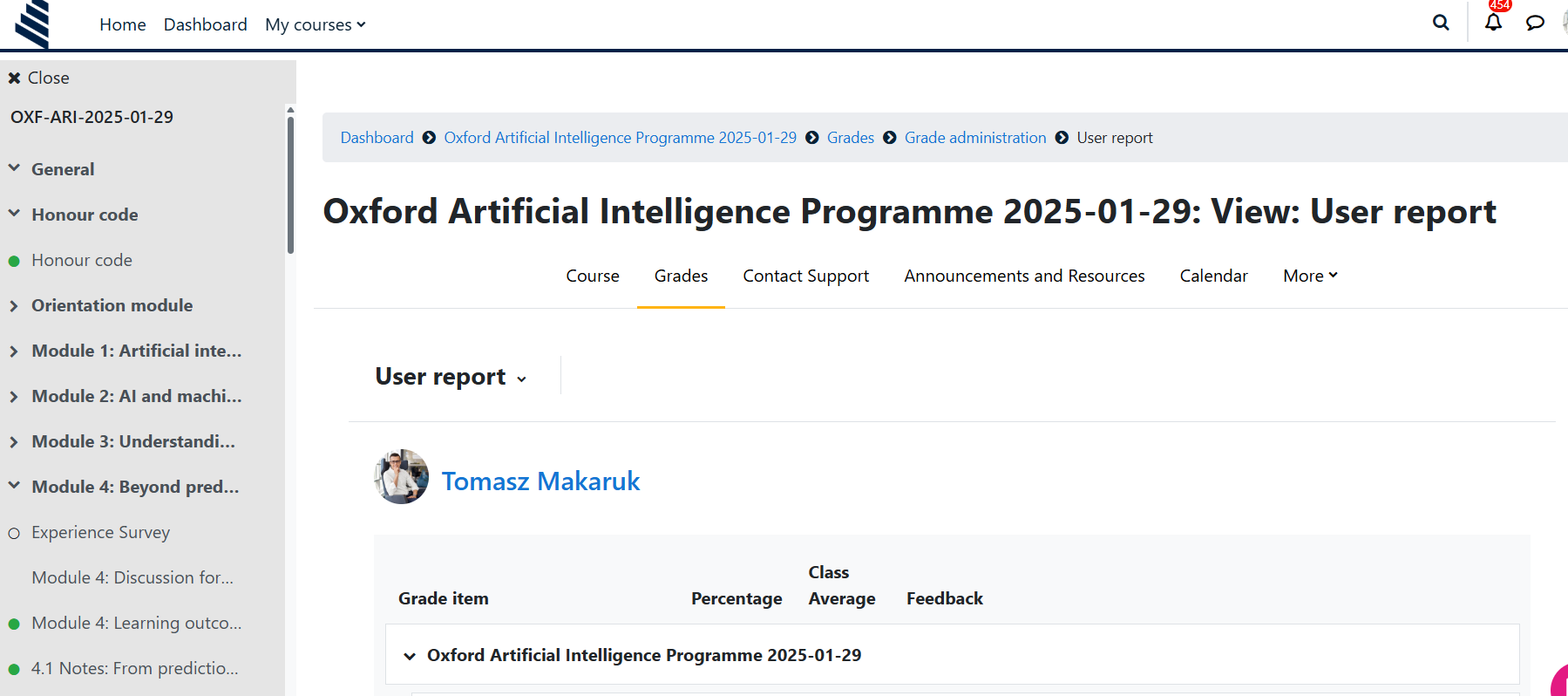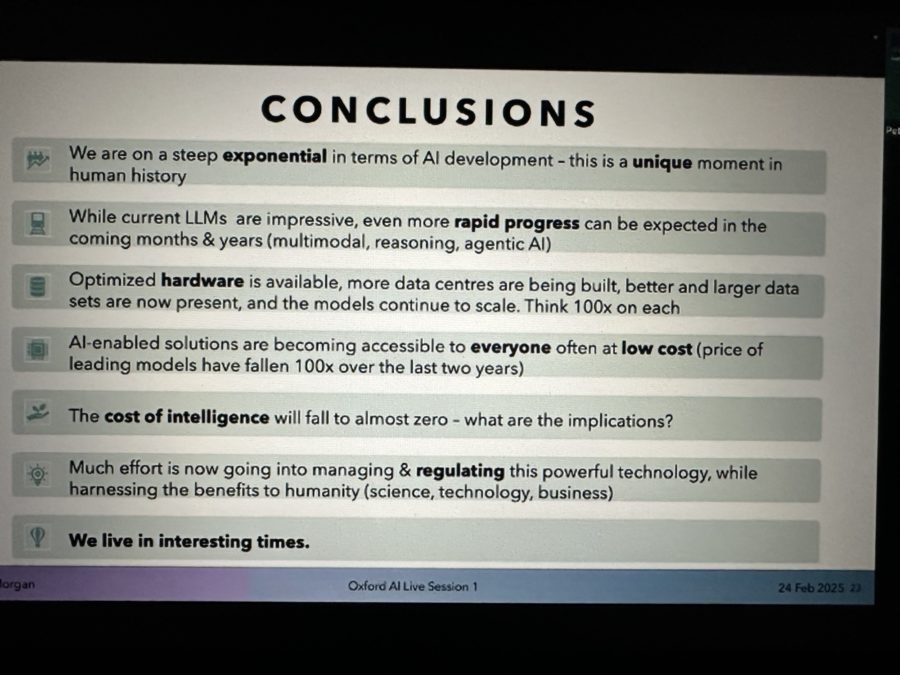My experience with the Oxford Artificial Intelligence Programme
This past January, I began a 6-week intensive course on artificial intelligence offered by the University of Oxford in collaboration with Saïd Business School. This paper details my experience.
Motivated by the increasing prominence of AI in daily life and a desire to understand how machine learning, I sought a course or study program offering comprehensive knowledge. My goal was to acquire practical insights that could later be implemented in guiding AI implementation in my professional work and within the tools developed by i360.
Choice of university
To minimize the risk of a poor investment of time, I prioritized courses from reputable academic institutions. Seeking a broad, unbiased understanding of AI, I avoided programs offered by corporations involved in specific AI ecosystems. My shortlist included: INSEAD’s „Transforming Your Business with AI’, London Business School’s „The Business of AI: Strategies for Leaders’, Harvard Business School’s „AI Essentials for Business’, IESE’s „Certificate in AI & Digital Transformation’ (which I seriously considered after an online interview with the course director), and the Oxford „Artificial Intelligence Programme”.
Ultimately, I chose the University of Oxford’s program based on an analysis of its curriculum and the stated emphasis on practical applications. The course keynote, „Understand the mechanics behind artificial intelligence, its potential and its challenges”, which was aligned with the website’s promise:
To understand artificial intelligence (AI) and its true potential – what it can and can’t do – you need to understand how the technology works. The Oxford Artificial Intelligence Programme is designed for managers, business leaders, and technical professionals across multiple functions and industries looking to understand the workings, possibilities, and ethics of AI technology. It provides a unique opportunity to develop an informed opinion about AI’s applications, as you reflect on its implications and limitations whilst building a business case for its implementation. The University of Oxford is a global centre for AI, with world-class research ranging from practical applications through to quantitative and computational principles of AI. The programme draws on this unique environment and multidisciplinary experts exclusively sourced from across the University of Oxford to provide a comprehensive exploration of AI and machine learning.
The decision proved correct, although the course’s intensity and the volume of material significantly exceeded my initial expectations.
Teaching method
The course employed a hybrid teaching model, combining text readings, on-demand video recordings, live online lectures, and group discussions. Participants were divided into small groups for discussions held via online forums and during live sessions. The central tool was the Online Campus, an e-learning platform guiding students through course tasks.

Fig. University of Oxford Online Campus.
The Online Campus served as the hub for accessing course content, submitting assignments, exchanging feedback with peers, and contacting professors and tutors. Notably, all materials could be downloaded locally, facilitating offline study, such as during travel or in areas with limited Internet access.
Course structure
The Artificial Intelligence Programme comprised an introductory Orientation module followed by six core modules:
- Module 1: Artificial Intelligence Ecosystem: Explored the history and potential of AI within the digital ecosystem.
- Module 2: Artificial Intelligence and Machine Learning: Delved into the mechanics („black box”) behind the three main types of machine learning.
- Module 3: Deep Learning and Neural Networks: Introduced deep learning and its role in modern AI approaches.
- Module 4: Working with Intelligent Machines: Covered machine intelligence concepts and AI’s impact on the job market.
- Module 5: The Ethics of Artificial Intelligence: Addressed the hierarchy of ethical and legal issues surrounding AI.
- Module 6: How to Use Artificial Intelligence in Your Business: Focused on identifying business opportunities for AI implementation.
Each module included introductory and summative surveys, plus a mandatory graded assignment („submission”). Progression required completing all elements of the previous module, including accepting the Code of Ethics in the Orientation module. Within a module, content could be accessed in any order, and previous modules remained accessible. However, new modules were released weekly (Tuesdays at 10:00 AM) and were only unlocked upon completion of the prior module’s requirements.

Credits
Completing each module required submitting a graded assignment („credit”). The assignment topic was provided at the beginning of each module. While this helped focus learning, it sometimes felt like studying solely for the assignment, a feeling that persisted throughout the six weeks. The seven-day deadline for each submission created significant time pressure. A welcome surprise was the detailed, personalized feedback accompanying the percentage grade for each assignment; it was clearly written by a human tutor and addressed specific aspects of the work. The assignment topics were as follows:
- Module 1/ Analyse the reasons for the success of mobile phones compared to the limited success of pagers. Based on the analysis and factors you identified in the question, describe the predicted trajectory that artificial intelligence will take over the next five years. In your answer, consider: the current short-term and medium-term needs of your organisation or your chosen organisation, the solutions that AI can offer to meet these short-term and medium-term needs of that organisation, and the main obstacles or impediments that the implementation of AI in that organisation may face.
Module 2/ Provide a brief evaluation of the different types of machine learning methods that can be used to improve the recommendation system in streaming portals and ultimately the results generated by the algorithm. Address the following questions in your answer: how can the performance of machine learning algorithms of this type be improved? Discuss the limitations of this approach. List at least two ways to improve algorithms of this type. What other learning methods can be used to generate a film recommendation system? Justify your answer.
- Module 3/ Think about how easily the human brain recognises numbers. Recognising numbers and handwriting, regardless of how different people write, comes naturally to the human brain. However, the same cannot be said for machines. When scientists want to train an algorithm to recognise written text, it is a complicated process. There are many nuances, features and technical aspects that need to be taken into account so that the algorithm can ultimately identify the digits accurately, regardless of who wrote them. Consider a sample of your own handwriting and identify the main challenges in automatically identifying handwritten digits that an artificial intelligence system would need to recognise.
- Module 4/ How could your organisation (or an organisation you know) best use generative artificial intelligence? What problems might your organisation face when implementing a generative AI strategy?
- Module 5/ Think about generative AI tools used to generate healthcare advice, instructions for operating or repairing heavy equipment, or advice on investing in financial products. Develop at least five specific ethical principles that your organisation or your chosen organisation should instil in its AI applications. The principles should be designed to prevent harm and unethical behaviour of AI applications. The purpose of the principles is to ensure ethical AI practices throughout the organisation.
- Module 6/ The purpose of this assignment is to make a case for the use of artificial intelligence in your organisation or an organisation of your choice. Your text should be clearly and logically structured and should demonstrate your understanding of the feasibility of implementing artificial intelligence in your organisation. Identify the framework you will use based on the following two options: Option 1: If you have chosen to complete this assignment based on your own organisation and your organisation has a well-established framework for making a business case, you can use this framework to complete this assessment. Option 2: If you have chosen to complete this exercise for your chosen organisation, or if your organisation does not have a well-established framework for making a business case, you must use the five-step framework that you have explored in the infographic in this unit.
Example assignment feedback received:
Dear Tomasz,
Your response in Q.1 provides an excellent attempt at identifying the challenges that an AI system might have in recognising handwriting. You effectively discuss handwriting characteristics, medium variations, and different numeral systems, demonstrating a strong understanding of the complexities involved.
In Q.2, your response provides an excellent attempt at recommending ways to address the identified challenges. You correctly emphasize the importance of diverse training datasets and highlight the role of neural network architecture in improving recognition accuracy. Your mention of noise reduction techniques and dataset expansion is particularly strong. Briefly expanding on preprocessing techniques such as normalization and augmentation for handling skewed or noisy data would add depth to your analysis.
In Q.3, your response provides a good attempt at identifying features of handwritten digits. You correctly discuss symmetry, straight vs curved lines, writing tools, and cultural writing differences. However, your response could be strengthened by explicitly comparing digits based on features such as pixel density, enclosed spaces, and relative positioning of strokes to further refine the neural network’s learning process.
Best regards,
This programme marked my first engagement with purely academic learning since completing my PhD at the Warsaw School of Economics over a decade ago. Waiting for assignment assessments and tracking my progress relative to other participants was an interesting aspect. My results were:
My assessment | Average rating of participants | |
1 | 93,8% | 83,0% |
2 | 93,8% | 82,0% |
3 | 96,4% | 82,1% |
4 | 91,7% | 81,9% |
5 | 87,5% | 77,2% |
6 | 87,5% | 80,8% |
Summary
I dedicated approximately 12 hours per module to absorbing the material and completing the assignment, totaling roughly 72 hours for the entire course. Balancing this demanding schedule with work, family, and daily sports activities was challenging. My solution involved starting one workday each week at 2:00 and dedicating most of Sunday to study. While this regimen allowed me to manage my commitments, it came at the cost of sleep and free time. Since completing the course, the sense of having regained free time is palpable.

Fig. Probably the best summary of the AI content during the closing lecture
As an economist by training, subjects like statistics, programming, engineering, biotechnology, neuropsychology and econometrics were largely unfamiliar. There were moments I questioned my presence in the course, which I interpreted as confirmation I was indeed stepping outside my comfort zone.
A standout quote from the course came from Stanford University professor Andrew Ng: “Artificial intelligence will not replace people, but people using AI can replace those who do not.” This perspective resonates with broader discussions on technology’s impact on the job market, where experts emphasize that effectively leveraging new tools like AI will be crucial for future work.
Ultimately, was the effort worthwhile? Yes, it was.
0
